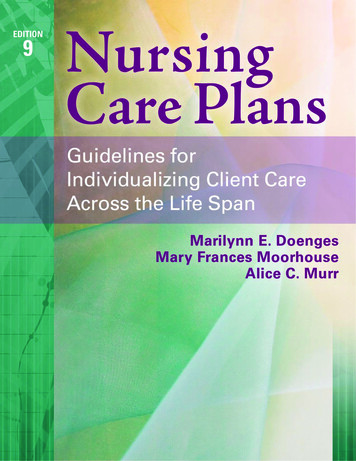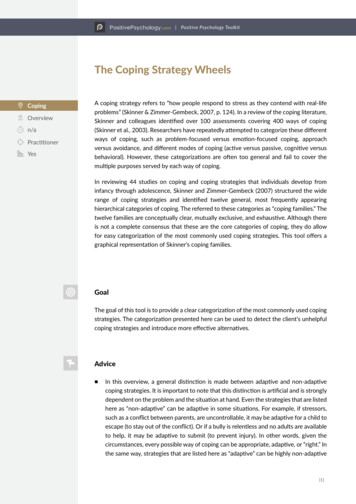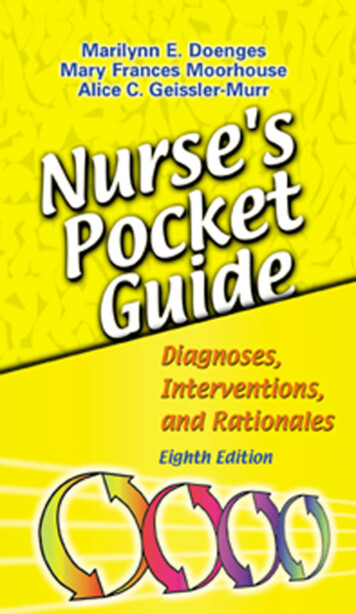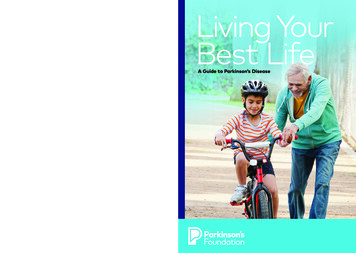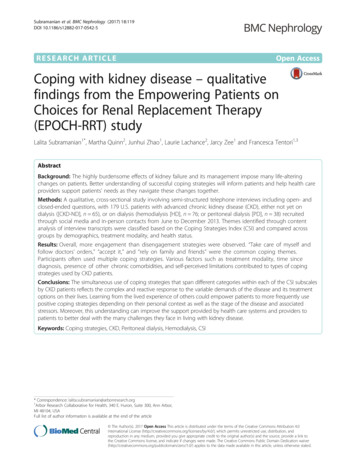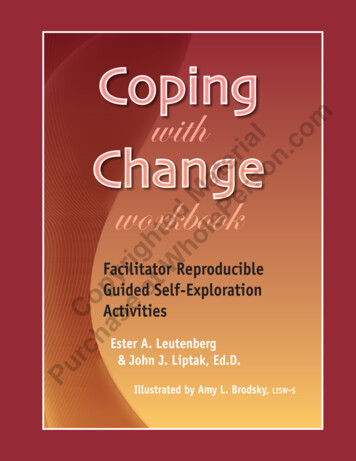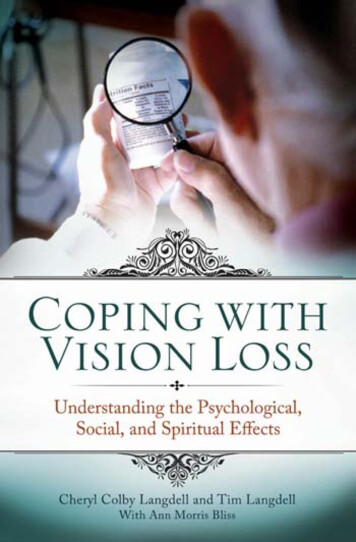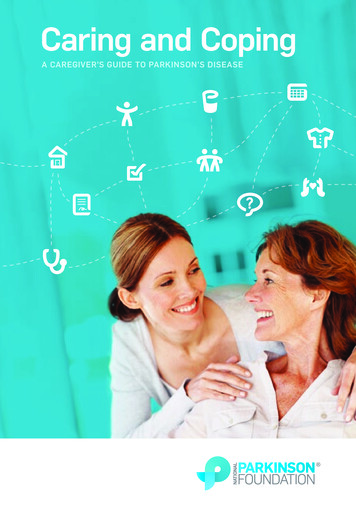
Transcription
Caring and Copinga caregiver’s guide to parkinson’s disease200 SE 1st Street, Suite 800Miami, Florida 331311359 Broadway, Suite 1509New York, New York 10018helpline:800. 4PD.INFO (473.4636)helpline@parkinson.orgparkinson. orgCaring andCopingA Caregiver’s Guide to Parkinson’s Disease
A personalized guide for:PERSON WITH PARKINSON’S NAME:PRIMARY CAREGIVER NAME:About the Parkinson’s FoundationThe Parkinson’s Foundation makes life better for people withParkinson’s disease by improving care and advancing research towarda cure. In everything we do, we build on the energy, experience andpassion of our global Parkinson’s community. A wealth of informationabout Parkinson’s and about our activities and resources is availableon our website, Parkinson.org.Your feedback matters!We’d like to know what you think of our publications and programs.Please take a few moments to fill out our online feedback form.Your answers will be used to improve our resources and will benefitpeople with Parkinson’s, caregivers, families and others in theParkinson’s community. Thank you for your help.Online form:Parkinson.org/feedbackYour generosity makes this publication possible.The Parkinson’s Foundation is proud to provide this booklet and othereducational materials at no cost to people around the globe. If you foundthis book helpful, please consider a gift so that we may continue to fightParkinson’s on all fronts: funding innovative research, providing supportservices and offering educational materials such as this publication.Thank you for your support.Donate online:Parkinson.org/donateDonate by mail: Parkinson’s Foundation200 SE 1st St, Suite 800Miami, FL 33131parkinson’s foundation resourcesCertain pages include tip sheets and with practicalpointers and worksheets to help keep importantinformation organized and easily located. You canfind more helpful tips for managing Parkinson’s inthe books, fact sheets, videos and newsletters inour PD library at Parkinson.org/library.Donate by phone:1-800 -4PD-INFO (473-4636)Tax ID:13-1866796The information contained in this publication is provided for informational and educationalpurposes only and should not be construed to be a diagnosis, treatment, regimen or anyother healthcare advice or instruction. The reader should seek his or her own medical orother professional advice, which this publication is not intended to replace or supplement.The Parkinson’s Foundation disclaims any responsibility and liability of any kind inconnection with the reader,s use of the information contained herein. 2018
Welcome to Caring and Coping,the complete guide for managingParkinson’s disease (PD). Thisworkbook is for those who care for andabout people living with Parkinson’s.PD impacts each person in a differentway, so there is no one-size-fits-allapproach to caregiving.Your journey is unique. 1
2IntroductionWhether the Parkinson’s diagnosis is new to yourloved one or you have been living with Parkinson’sfor a long time, you have the right and responsibilityto make the care partnership as productive as possible,with the least amount of stress and conflict. Preparationis key in all respects: emotional, financial and physical.We hope that the tips and tools in this workbook willhelp prepare you for every step of the journey.What is caregiving?A precise definition remains elusive, despite growing numbers of peopleserving in the role of family caregiver. It is estimated that there are almost45 million family caregivers in the United States, and more than threequarters of them care for someone over 50 years old.A 2014 report from the National Alliance for Caregiving suggeststhe following definition: “Caregiving is everything we do to assist afriend or relative due to that person’s illness or disability, and that wedo for our own health.” This book is focused on that dual role: you providecare for someone else – the “caring” part of Caring and Coping. Just asimportantly, you also must take care of yourself – the “coping” portionof this book’s title.
What is caregiving?Within this workbook, you will find the following:Tip sheetsThese offer practicalpointers for managingthe complex issues thatarise when you care forsomeone with Parkinson’s.The tip sheets can be foundthroughout this book withblue page borders.WorksheetsThese help you keep importantinformation organized and easilylocated. Make copies or downloadmore from Parkinson.org/library,so you can update them asinformation changes.The worksheets can be foundthroughout this book with graypage borders.VideosCheck out our CareMAP playlistat Parkinson.org/videos towatch videos with more tips andadvice from caregivers and careprofessionals to make your life easier.Caregiver storiesYou are not alone! Learnfrom and take comfort inthe experiences of otherpeople who care forsomeone with Parkinson’s.3
4ContentsIntroduction 2Resources 6My Contacts Worksheet 8Early in the Journey: Your Caregiver Identity 11Caregiver Identity 14How to Talk with Your Family About Parkinson’s Tip Sheet 15The 7 Needs of Caregivers 16Balancing Work and Caregiving 20Caring for the Caregiver 23Caring for You Tip Sheet 26Finding Meaning in Caregiving 28Managing Caregiver Stress Tip Sheet 32Caregiver Self-Assessment Worksheet 38Practical Pointers 41Organizing Medical Information 44Communicating with the Healthcare Team 45Preparing for a Medical Appointment Tip Sheet 50General Health 52The Importance of Exercise and Activity for People with Parkinson’s Tip Sheet 53Cueing Strategies 54Addressing Communication Challenges Tip Sheet 55Coping with Fatigue Tip Sheet 56Making Daily Life Easier Tip Sheet 57Safety Considerations 58Medical Appointment Worksheet 62Medications and Schedule Worksheet 64Parkinson’s Symptoms Diary Worksheet 66Caring from Afar 73Secondary Caregiving Tip Sheet 76What Not to Do Tip Sheet 78Primary Caregiving from Afar Tip Sheet 8
5Getting Outside Help 83When Is It Time to Get Help? 86Where to Find Help 88Action Plan for Hiring In-Home Caregivers Tip Sheet 90Deciding to Hire through an Agency or Privately 92Preparing Paid Caregivers Tip Sheet 94Respite Care 98Rehabilitation and Parkinson’s Disease 102Daily Routine Worksheet 104Adding Family, Friends and Volunteers to Your Caregiving Worksheet 106Orienting a New Home Care Worker Worksheet 108Questions to Ask a Potential Paid Individual Caregiver Worksheet 110Questions to Ask a Potential Paid Agency Caregiver Worksheet 112Planning Ahead 115Be Prepared 118Maintaining Important Information 119Advance Care Planning 120Is a Care Facility Needed? 124Advanced Parkinson’s 129What Is Advanced Parkinson’s? 132Plans and Scheduling Tip Sheet 134Movement Challenges Tip Sheet 136Getting Up from a Fall Tip Sheet 139Dressing Tip Sheet 142Mealtime and Swallowing Tip Sheet 144Bathroom Tip Sheet 148Thinking Changes and Dementia Tip Sheet 151Medications On Time, Every Time Tip Sheet 154Skin Protection Tip Sheet 157Managing Pain Tip Sheet 158Activities at Home Tip Sheet 159Travel and Transportation Tip Sheet 161Rest and Sleep Tip Sheet 166End-of-Life Planning 169Palliative and Hospice Care 172When Caregiving Ends 174
6ResourcesContact the Parkinson’s Foundation HelplineYour first call can always be to the Parkinson’s Foundation Helpline:800-4PD-INFO (473-4636). Trained Parkinson’s disease informationspecialists will give you up-to-date information about Parkinson’s, referralsto healthcare professionals, a wide variety of free publications, emotionalsupport, community resources and more. You can also email us athelpline@parkinson.org at any time.Aging ResourcesThese organizations offer information about services for all older adults.Aging Life Care Association 520-881-8008, www.aginglifecare.org ational Association of Area Agencies on Aging 202-872-0888,Nwww.n4a.org Alliance for Aging 800-96-ELDER (963-5337), www.allianceforaging.orgAARP 888-OUR-AARP (687-2277), www.aarp.orgNext Avenue www.nextavenue.orgRead the special report, Transforming Life as We -life-ageCaregiver AssociationsThese groups provide a range of options for caregiver education,support and networking.Family Caregiver Alliance 800-445-8106, www.caregiver.orgNational Alliance for Caregiving 301-718-8444, www.caregiving.orgCaregiver Action Network 202-454-3970, www.caregiveraction.orgMedication AssistanceThere are general medication assistance programs as well asprograms specifically for low-income individuals and families.NeedyMeds 800-503-6897, www.needymeds.orgPartnership for Prescription Assistance www.pparx.orgSome pharmaceutical companies provide medication to people whocannot afford it. RxAssist (www.rxassist.org) offers a database ofthese patient assistance programs.Patient Access Network Foundation Parkinson’s DiseaseAssistance Program 866-316-PANF (7263),www.panfoundation.org/parkinsons-disease
7U.S. Government AgenciesThere are various government programs you and the person withParkinson’s might be eligible for. Call or visit their sites for informationand to find out whether you qualify.Centers for Medicare and Medicaid Services800-MEDICARE (800-633-4227), www.medicare.govSearch or ask for the State Pharmaceutical Assistance Programs,the Medicare Savings Programs and the free publication Medicare & You.Social Security Administration 800-772-1213, www.ssa.govSearch or ask for the Supplemental Security Income Benefits.Eldercare Locator 800-677-1116, www.eldercare.govDepartment of Veterans Affairs 800-827-1000, www.va.govNational Institute on Aging 800-222-2225, www.nia.nih.govActivities of Daily LivingThere are many products that can help with activities of daily living.Below are just a few of the many companies that offer such products.ClothingBuck & Buck 800-458-0600, www.buckandbuck.comMagnaReady 866-635-8866 www.magnaready.comMedical EquipmentIndependent Living Aids, LLC 800-537-2118, www.independentliving.comIn-Step Mobility Products, Inc. 800-558-7837, www.ustep.comNational Seating and Mobility 615-595-1115, www.nsm-seating.comReliable Medical Supply, Inc. 763-255-3800, www.reliamed.comAdvance DirectivesThere are several groups that can help you document your medicalwishes and preferences.American Bar Association 800-285-2221, www.americanbar.orgSearch or ask for the Toolkit for Advance Planning.Aging with Dignity, Five Wishes www.agingwithdignity.orgNational Hospice and Palliative Care Organization, Caring Connections800-658-8898, www.caringinfo.orgNational Physician Orders for Life-Sustaining Treatment (POLST)Organization 503-494-4463, www.polst.org
WorkSheet8My ContactsMedical ContactsPRIMARY CARE NAME:PHONE #:ADDRESS:OTHER INFO:NEUROLOGIST NAME:PHONE #:ADDRESS:OTHER INFO:DENTIST NAME:PHONE #:ADDRESS:OTHER INFO:EYE DOCTOR NAME:PHONE #:ADDRESS:OTHER INFO:PREFERRED HOSPITAL NAME:PHONE #:ADDRESS:OTHER INFO:PHARMACY NAME:PHONE #:ADDRESS:OTHER INFO:OTHER NAME:PHONE #:ADDRESS:OTHER INFO:OTHER NAME:PHONE #:ADDRESS:OTHER INFO:OTHER NAME:PHONE #:ADDRESS:OTHER INFO:
Personal ContactsEMERGENCY CONTACT NAME:PHONE #:ADDRESS:OTHER INFO:FRIEND/FAMILY NAME:PHONE #:ADDRESS:OTHER INFO:FRIEND/FAMILY NAME:PHONE #:ADDRESS:OTHER INFO:NEIGHBOR NAME:PHONE #:ADDRESS:OTHER INFO:TRANSPORTATION SERVICE NAME:PHONE #:ADDRESS:OTHER INFO:GROCERY HOME DELIVERY NAME:PHONE #:ADDRESS:OTHER INFO:OTHER NAME:PHONE #:ADDRESS:OTHER INFO:OTHER NAME:PHONE #:ADDRESS:OTHER INFO:OTHER NAME:PHONE #:ADDRESS:OTHER INFO:9WorkSheetMy Contacts
10AcknowledgementsThis book was written and reviewed by expertsin Parkinson’s disease and Parkinson’s care:Joan Gardner, RN, BSNRose Wichmann, PTStruthers Parkinson’s CenterDiane Breslow, MSW, LCSWPaula Wiener, MSW, LCSWParkinson’s FoundationThis book has been made possible through thegenerous donations of thousands of individualsaffected by Parkinson’s and grants fromDesign: Ultravirgo
My ContactsCHAPTER OneEarly inthe Journey:Your CaregiverIdentity11
12Early in the Journey:Your Caregiver IdentityParkinson’s is a progressive disease: it changes over time.That can make it hard to define your role in your lovedone’s journey, as your involvement and responsibilities willchange along the way. This section includes tip sheetsrelated to figuring out how Parkinson’s fits into your life.This includes sharing the diagnosis with family, assessingyour work life and prioritizing your own needs.IN THIS CHAPTERCaregiver Identity 14How to Talk with Your Family about Parkinson’s 15The 7 Needs of Caregivers 16Balancing Work and Caregiving 20
My Contacts13
14Early in the JourneyCaregiver IdentityWhile your loved one’s Parkinson’s diagnosis probablychanged your life overnight, caregiver is a role and anidentity that you grow into.Each person with Parkinson’s is unique, and so is each caregiver.As you start the journey, define “caregiving” for yourself. For somepeople, caregiver is one of many roles, or a group they belong to.For others, it is a central characteristic.Many people do not like the term “caregiver.” Especially early in theParkinson’s journey, you might not feel like you are actually “giving” care.Similarly, the person with Parkinson’s might not see himself or herself assomeone in need of care. But remember, care is not limited to physicaltasks. Care can be emotional and spiritual as well as physical.However you define it, and whatever term you choose – caregiver, carepartner, carer, etc. – it is important that you accept this new role. It doesnot have to erase or replace any existing ways you self-identify; it is anaddition, a new facet of your identity that will help you and your loved oneface Parkinson’s disease together.As your loved one progresses through stages of Parkinson’s, you willprogress through stages of caring. You will have to take on new tasksand learn new skills. Learn all you can about the disease early on, so youcan participate in healthcare discussions, make informed decisions andprovide emotional and physical support now and as needed in the future.And always remember to consider your own needs for wellness, self-careand support.
How to Talk with Your FamilyAbout Parkinson’sFamily members want to understand and help.How do you begin to explain Parkinson’s disease to them?First, you must understand the disease yourself. The Parkinson’sFoundation offers several options to help you and your family learnall about Parkinson’s disease (PD), including warning signs, diagnosis,symptoms, treatment, living well and much more.» Explore Parkinson.org for information on any PD topic.» Call our toll-free Helpline at 1-800-4PD-INFO (473-4636).Our PD Information Specialists can answer your questions,provide resources and offer referrals and support.» Order your free copy of our publication What You and Your FamilyShould Know. Get it online (Parkinson.org/books) or by calling theParkinson’s Helpline.Your family may have questions or fears about Parkinson’s and genetics.For the vast majority of people, Parkinson’s is not inherited. There is notest that can accurately predict who will develop Parkinson’s. Extensivegene and biomarker research is underway to uncover the possibleprecursors – not necessarily causes – to disease development.People unfamiliar with Parkinson’s often think of it only as a disorderof movement. It is important to help family understand that there areother facets of the disease, and these can have an even greater impact onquality of life than the motor symptoms. Emphasize that Parkinson’s is anongoing journey, one in which we need to face realities little by little, makeadaptations, stay connected to the people and things that are importantto us and live each day in the best way possible.Engage your family to help them understand.» Include your family in care planning discussions. Ask for theirobservations about how the person with Parkinson’s is doing.» Make specific, concrete requests to your family members about howthey can help you or the person with PD.» If your family members live out of town, refer them to the Parkinson’sFoundation website and Helpline for information, referrals and answersto any questions.tip sheet15
16Early in the JourneyThe 7 Needs of Caregivers1 Education about Parkinson’s disease Understand the symptoms. Learn about available treatments. Consider the impact of Parkinson’s on everyday life. Access resources. Explore your role in caregiving.2 Time management Make daily and weekly lists of things to do.Make sure the tasks are manageable and realistic. Prioritize: do the most important or difficult things first.Check off what’s done. Save up errands to do more of them at one time. Take a small task with you if you are going some placewhere you have to wait. Delegate what can be delegated. Forget unnecessary tasks. Take a break when pressure gets too great, or as a reward. Don’t do so much in one area that you cannot be effective in another. Break large tasks into smaller, more doable parts. Establish and stick to routines. Recognize that some amount of time will be spent on thingsbeyond your control. Many tasks and activities will take longerfor the person with Parkinson’s as the disease progresses.
173 Self-care, health and respite Build in quality time for yourself (1–1½ hours a day, if possible)and protect it. Keep up with your own needs, hobbies and regular activities. Exercise: it leads to better sleep, decreased tension and depressionand increased energy. Eat a balanced, nutritious diet. Drink water. Recognize when you are stressed. Get enough rest. Take time to relax. Maintain a sense of humor. Get regular check-ups and keep your own medical appointments. Think about your future.What goals do you hope to achieve, and how can you achieve them?Can your loved one help you achieve them? Set limits and stick to them.Bring in outside help (family or paid worker) so that you cantake a break.How to Categorize and Prioritize Needs:Building Your Plan1. Identify your concerns according to the categories in this section.2. Place your needs and concerns in priority order.3. Consider and write down “action steps” that you can take.4. Discuss your ideas with others.5. Devise a step-by-step plan.6. Implement the steps with help from others as needed.
18Early in the Journey4 A support team Share the care. Explore ways to get assistance and support as needed.This may include both physical and emotional help. Develop your coping skills. Caregivers experience a wide variety ofemotions. Give yourself permission to feel sad or frustrated at times, butalso take time to enjoy life. Focus on the present, the needs and rewardsof the day. Try not to be critical of yourself in moments of anger. Giveyourself credit, not guilt, and try to forgive any mistakes. Use positiveself-talk: for example, tell yourself, “I am doing a good job.” Know that itis okay to grieve the losses that you and your loved one may experience.Research shows that writing – in a journal or other format – can help youwork through your feelings and emotions. What causes you to mourn?Where do you find satisfaction and pleasure? Develop your emotional and spiritual support networks. Include yourhealthcare team (physician, nurse, social worker, etc.), family, friends,neighbors, support group and individual support group members, clergy,volunteers and online support forums. Seek comfort from your faith, faithcommunity and spiritual practices. Find meaning, insight, understandingand your own inner strengths. Adjust your expectations: Life and youare not perfect. Accept changes as they occur. Get help if necessary.Remember, it is a strength, not a weakness, to ask for help, includingemotional help or counseling. Each person experiences depression in aunique way. It is important to take seriously any symptoms you experiencethat could signal depression; you should not feel embarrassed or ashamed. Be aware of the core symptoms of depression:– Sleeplessness– Feeling slowed down or restless inside– Loss of appetite– No interest in once-pleasurable activities– Difficulty concentrating– Thoughts of death or suicide– Feelings of hopelessness and worthlessnessIf you think you may be depressed, talk to a doctor or mental healthprofessional about your symptoms. Find a supportive professionalthat you trust and with whom you feel comfortable. In most cases,depression is effectively treated with psychotherapy, antidepressantmedications or a combination of both, plus activities such as regularexercise, spirituality, supportive social interactions and meditation.
The 7 Needs of Caregivers195 Your relationship with the person with Parkinson’s Maintain open communication. When conversing, remove or turn off loud and distracting noises. Express love and appreciation as well as concerns and feelings offrustration. Don’t let those feelings transform into resentments. Match your expectations to the reality of your loved one’s actionsand abilities. Share special time together apart from caregiving tasks.6 Medical, financial and care decisions Define and clarify issues, including family participation in caregiving,advance directives, long-term care options or other topics as earlyas possible. Devise steps for carrying out these plans. When making decisions about hands-on care, ask if your decisionpromotes your loved one’s independence: Do not confuse “caring”with “doing.”7 Community resources Take advantage of physical and practical assistance and products. See what resources local associations have to offer. Seek education materials. Many organizations(including the Parkinson’s Foundation) provide these for free. Get legal documents (e.g., power of attorney for healthcare) in order.(See “Planning Ahead” section starting on page 115 formore information.) Explore resources for financial assistance, e.g., disability. Reach out to a variety of professionals, such as specialist physicians,nurses, therapists, social workers and clergy.
20Early in the JourneyBalancing Work and CaregivingCaring for someone with Parkinson’s disease can be afull-time job, especially as the disease progresses to amore advanced stage. At first, you may be hesitant totell your employer about your situation. However, it maybe helpful to see if your workplace offers any specialaccommodations for caregivers. Look into your company’s personnel policies. Check your employeehandbook or staff website, or talk to someone from the humanresources department to learn if your company offers programs orspecial assistance for caregivers. If you are a union member, ask aunion representative to help you negotiate with your employer. Arrange a meeting with your boss, and prepare for it in advance.Before you approach your boss, decide if you want to discuss yoursituation as a caregiver, or if you want to go further and requestspecific job accommodations. Jot down the most important pointsyou want to address. Be upfront and positive. When you meet with your supervisor, highlightyour strengths and contributions to the company. Indicate yourwillingness to work together to identify potential accommodations tohelp you continue to do your job while maintaining your role as caregiver. Get it in writing. Send an email to your manager or HR representativewith your understanding of the agreed-upon conditions. This will giveeveryone a reference point.
21Later, if you consider leaving work altogether to accommodateyour caregiving duties, consider the following steps: Explore your options. What are your alternatives to resigning? Forexample, can you take a career break or retire early? Will your employerlet you work remotely or part-time? Would you want to consult orfreelance on a schedule that is more suitable to your needs? Take the time you need. The Family Medical Leave Act (FMLA) entitleseligible employees of covered employers to take unpaid, job-protectedleave for specified family and medical reasons. During such leave,group health insurance coverage continues under the same terms andconditions as before the leave. Eligible employees are entitled to 12 weeksof leave in a 12-month period in order to care for a spouse, child or parentwith a serious health condition. Understand the repercussions of your options. Ask yourself: Can Imanage with less money (and any effect on a pension or retirementplan)? Do not take this decision lightly. Think about the current andfuture loss of income if you leave your job. In addition to the possiblefinancial consequences, you should consider the potential loss ofindependence, social contact and valuable skills. This may cause sadnessor resentment. At the same time, the person with Parkinson’s may feelbitter about his or her own loss of independence. Both of you must cometo terms with these changes and these emotions.I’m a writer, and I do have to spend a lot of time in my professionworking, lecturing and giving workshops, and that’s not easy to do.It is easy if you’ve taken out a long-term insurance policy and somebodycomes every day and it’s taken care of, otherwise it can be a bigfinancial burden. I find that I just have to take time because it’s ourincome and it’s our livelihood. Jerry’s very understanding about that.– CAROLYN, CARES FOR HUSBAND, GERALD
22Early in the JourneyIt’s a matter of waking up in the morning and saying,‘I’m glad I’m here, I’m going to make the best of it,and I really am going to enjoy my life.’ Forget aboutParkinson’s; it’s not going to go away. But we can dealwith it, we can handle it and we can find wonderfulthings to do with our lives.– CAROLYN, CARES FOR HUSBAND, GERALD
Balancing Work and CaregivingCHAPTER twoCaring forthe Caregiver23
24Caring for the CaregiverCaregivers have an enormous, often underappreciatedjob. The job is unique for each caregiver but carries manycommon stresses, concerns, fears and rewards. Thissection is designed to help you, the caregiver, understandand handle your own particular caregiving situation, sothe role can continue to be – or return to being – a healthy,viable, even rewarding option for you.IN THIS CHAPTERCaring for You 26Finding Meaning in Caregiving 28Managing Caregiver Stress 32Caregiver Self-AssessmentWORKSHEET38
Balancing Work and Caregiving25
tip sheet26Caring for the CaregiverCaring for YouYou may be involved in assisting the person withParkinson’s with many activities of daily living andmedical tasks, as well as maintaining a household;shopping and preparing meals; organizing records,papers and appointments; transporting your loved oneto healthcare visits; keeping up with social and familyrelationships and many other tasks. At the same time,you may be working, raising children or grandchildrenor coping with your own health or personal issues.Research from the National Alliance for Caregiving shows the top fourcaregiver concerns:1) Keeping your loved one safe2) Managing your own stress3) Finding activities to do with your loved one4) Taking time for yourselfResearch also reveals that when caregivers are asked what they want,the majority respond that they want information about coping with beinga caregiver. This information takes several forms, including knowledgeabout the disease, comfort with the caregiving role and managing stress.The following tips can help you cope.» Forgive yourself for not being perfect. Caring for someone with a chronicillness means your world has been turned upside down. Your daily routinewill definitely change, and you will probably have to compromise someof your personal standards of housekeeping, meal preparation and othertasks. Accept your own humanity. Give yourself a pat on the back fordoing the best you can.Watch the videoAdvice for Caregivers,from CaregiversOnline at Parkinson.org/videos in the“CareMAP Caregiver Stories” playlist
» Acknowledge your right to feel emotionally off-balance. Recognize thehidden grief component of your anger, anxiety, guilt and depression.Expect adaptation to, but not resolution of, your grief. Accept it andseek out someone who understands it.» Determine your limits. What is your comfort level providing care? Somepeople feel uncomfortable when incontinence becomes an issue. Somedetermine they can provide care at home as long as others in the familycan put up with the disruptions. Everyone has limits. What are yours?» Make regular breaks from caregiving a priority. You cannot be a goodcaregiver to someone else if you do not take care of yourself. Your lovedone can survive a few hours and, periodically, a few days without you.» Be kind to yourself. Remember you are experiencing normal reactionsto abnormal circumstances.» Seek out joy in your relationship with the person with Parkinson’s.Your hands-on duties, such as bathing and dressing your loved one,might feel like work, but these tasks bring you together. Add some funto your hands-on care: sing songs, tell jokes, share goals and dreams.» Develop a habit of participating in activities together outside cares.Shared time as husband-wife, mother-daughter, siblings or otherrelationship – rather than as caregiver and care recipient, or even carepartners – allows you to enjoy each other and build happy memories.» Try to forgive your loved one for past hurts. Resentment toward pastwrongs and injustices will make your present caregiving role difficult. Let goof what was, and concentrate on making what is healthy and productive.Being a caregiver is probably the most difficultjob you’re ever going to have. The only way youcan do it is to take care of yourself. You cannotsay, ‘I don’t have time for me.’ The person you’retaking care of wants the best for you becauseyou’re giving the best to them. Don’t be a martyr.It’s okay to take care of yourself.– KAREN, CARED FOR FATHER, JOSEPHtip sheet27
28Caring for the Caregiver Finding Meaning in CaregivingLike most things in life, caregiving is not an either/orexperience. Caregiving offers trials and triumphs as wellas challenges and joys. A Caring Today survey found thata majority of caregivers exper
Activities of dAily living There are many products that can help with activities of daily living. Below are just a few of the many companies that offer such products. clothing Buck & Buck 800-458-0600, www.buckandbuck.com MagnaReady 866-635-8866 www.magnaready.com Medical equipMent In
